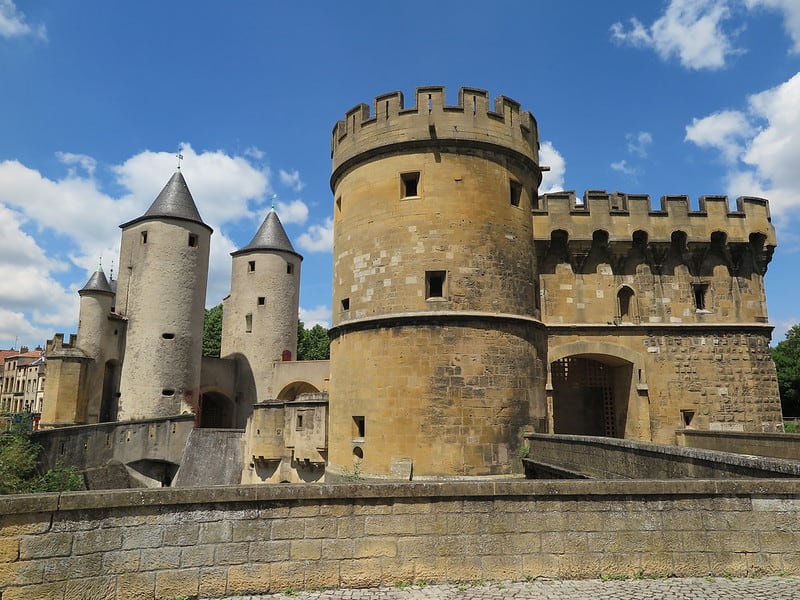Metz is an iconic city with Jaumont limestone buildings and a bustling shopping centre. It also has charming small squares and delicious food to be enjoyed by all visitors.
Metz is home to several museums that showcase archaeological finds, medieval art and religious artwork from different eras. One such gallery is Musee de la Cour d’Or which boasts impressive collections spanning from Gallo-Roman times up through Renaissance period.
Metz Cathedral
Metz’s cathedral, rising to 42 metres above street level, has earned the city its nickname of “La Lanterne du Bon Dieu”. Inside, visitors will find many stained glass windows created by Renaissance and Gothic masters as well as modern artists like Marc Chagall.
On a cloudy day, the cathedral radiates with an incredible light. The yellow Jaumont limestone makes the building appear luminous, while its arcade openings cast light like large lanterns.
For an insightful look into Metz’s history, visitors should visit Musee La Cour d’Or. Here you will find art from Metz’s Gallo-Roman and Merovingian past as well as an impressive collection of medieval sculptures.
Metz’s Centre Pompidou, completed in 2010, is another must-visit. This branch of the iconic Pompidou Center in Paris features a roof structure shaped like a Chinese hat and its expansive galleries showcase “Beacons” – rotating exhibitions of painting, sculpture and photography from the National Museum of Modern Art in Paris.
Gare de Metz-Ville
If you’re searching for an exciting way to spend some time in Metz, the Gare de Metz-Ville should be on your list. This main railway station has been registered as a historic monument since January 15, 1975.
You’ll find the Gare de Metz-Ville on Avenue Foch in Metz’s Imperial Quarter. Founded during Kaiser Wilhelm II’s reign in the early 20th century, this part of Metz is worth exploring for its rich cultural heritage.
Its facade, roof, departure hall, honorary lounge and former station restaurant have been declared historic monuments by law. Known as the Station Palace because it housed Kaiser Wilhelm’s apartments, make sure to explore this iconic landmark while in Metz-Ville.
Another must-visit is Le Temple Neuf, a Romanesque revival building situated on Petit-Saulcy river island just off Place de la Comedie. Its dark grey sandstone stands in stark contrast to Jaumont limestone used for most of Metz’s other historic buildings. At night its arcade openings shine like large lanterns and its view reflected in the water from Pont Moyen is one of Metz’s iconic sights.
Porte des Allemands
Metz’s sole remaining medieval city gate, La Porte des Allemands, serves as a museum with information about its history, artifacts from times past, and some archeological finds. Inside you’ll find seventeen rooms dedicated to this purpose.
The Germans’ Gate, also known as the gate of Teutonic Knights, is an iconic remnant of medieval fortifications on the east side of Metz. It boasts two 13th-century round towers and 15th-century gun bastions.
Metz Castle played a pivotal defensive role during Emperor Charles V’s siege of Metz in 1552-1553. While it needs some repair, it remains well worth visiting today.
Furthermore, the Temple Neuf is an exquisite church situated atop a bluff overlooking the Moselle River, constructed between 1901 and 1904. It has been designated an historic monument since 1930.
Lorraine boasts many historic towns with elegant UNESCO-listed squares and outstanding art museums. Furthermore, Lorraine is renowned for its delicious cuisine – from starters to desserts you can sample an array of delectable dishes.
Fort de Queuleu
Metz is a charming French city renowned for its stately old buildings, lush green spaces and exciting culture. Popular tourist attractions include the cathedral and nearby neighborhoods.
For something truly unique, why not book a tour of the UNESCO-listed Fort de Queuleu? During WWII, this bunker served as a German prisoner camp and is open on weekends and for special events.
The museum houses an impressive collection of antiquities, including Roman and medieval remnants from Divodurum (modern-day Metz). Visitors can learn about Divodurum’s Jewish community, Merovingian tombs, religious art work, as well as medieval treasures at this historic landmark.
Quartier de la Citadelle neighborhood’s top attraction is the Chapelle des Templiers, featuring an unusual octagonal chapel designed by Cocteau. His paintings and stained-glass windows boast surreal religious motifs and geometric designs not typically found in traditional churches. Furthermore, this church frequently hosts music concerts and temporary exhibitions.
Marche Couvert
Metz is one of those French cities that gets overlooked, which is a shame as it has so much to offer. Rich in history, Metz makes for an enjoyable visit.
If you’re searching for something exciting in Metz’s city centre, Marche Couvert should not be missed. This charming covered market sits right in the city center and provides an ideal shopping experience when it comes to food products.
At this market, you’ll find an extensive selection of foods such as Moroccan couscous, Lebanese sandwiches, Italian deli specialties and fresh produce. It remains bustling throughout the day but especially busy at lunchtime when people flock to sample all the delectable snacks on offer.
Metz is not complete without visiting the Porte des Allemands, an ancient bridge castle and city gate dating back to the middle ages. Here, visitors can explore its towering stones and take a leisurely walking tour around the area.
La Cour d’Or
Metz is one of France’s best destinations for art and history enthusiasts. Here, you’ll find museums featuring collections of Roman and Medieval artwork.
The Cour d’Or museum stands on the site of an ancient palace where Merovingian kings of Austrasia reigned. It houses treasures uncovered during archaeological excavations, such as walls adorned with colored plaster and terracotta necklace beads.
It also boasts an impressive collection of paintings and sculptures, including works by Camille Corot, J.B. Eugene Delacroix and Gustave Moreau.
Metz offers plenty to explore, so be sure to plan your itinerary carefully. Allow at least three days for exploration of this charming city.
For anyone passionate about modern art, the Centre Pompidou should not be missed. This branch of the equally impressive Paris-based Pompidou center opened its doors in 2010, and features many masterpieces from their collection – works by Picasso, Fernand Leger and Joseph Beuys included.
Quartier Impérial
On the western edge of town, Quartier Imperial is an intriguing district to discover. Renowned for its stunning architecture, you’ll come across many landmarks like the railway station and Metropolitan Cathedral here.
Emperor Wilhelm II built the Metropolitan Cathedral to give Metz a more German atmosphere, reflecting his strong sense of German power. The cathedral stands as an impressive testament to this, boasting its impressive height and stained-glass windows.
One of the top things to do in Metz is attending a show at Theatre on Place de la Comedie. This Neoclassical venue can seat 750 guests per performance and is one of the oldest still operating theaters worldwide.
Another popular attraction in the area is Centre Pompidou museum, which exhibits artworks by numerous artists. At 10,700 square meters of exhibition space, it’s no wonder why this building attracts so many tourists; plus, it hosts various events throughout the year.
Le Temple Neuf
One of the most captivating sights to behold in Metz France is the Temple Neuf, perched atop an idyllic island on the Moselle river. You can take in stunning views from Quai Paul Vautrin or capture its beauty at night when illuminated!
Temple Neuf, built in 1904, is an outstanding example of Romanesque Revival architecture inspired by the cathedrals of Speyer and Worms in Germany’s Rhineland region.
While in the city, be sure to take a walk along Place de la Comedie to admire its magnificent cathedral which is often illuminated at night. Alternatively, you can stroll along the Moselle riverbank for some truly picturesque views.
Another noteworthy attraction to visit is the Church of Saint-Pierre-aux-Nonnains, originally constructed as part of a Gallo-Roman bath complex in the 4th century. Nowadays it serves as both a museum and exhibition hall.
Foodies will love the Marche Couvert, a covered market where you can purchase all sorts of delicious local products. From cheeses and fruit to vegetables and charcuterie, you’ll find everything here – plus fresh bread!

